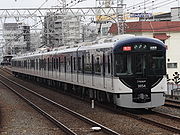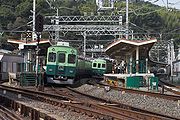
Keihan Electric Railway
Encyclopedia






Japan
Japan is an island nation in East Asia. Located in the Pacific Ocean, it lies to the east of the Sea of Japan, China, North Korea, South Korea and Russia, stretching from the Sea of Okhotsk in the north to the East China Sea and Taiwan in the south...
ese railway operator in Osaka
Osaka Prefecture
is a prefecture located in the Kansai region on Honshū, the main island of Japan. The capital is the city of Osaka. It is the center of Osaka-Kobe-Kyoto area.- History :...
, Kyoto
Kyoto Prefecture
is a prefecture of Japan located in the Kansai region of the island of Honshu. The capital is the city of Kyoto.- History :Until the Meiji Restoration, the area of Kyoto prefecture was known as Yamashiro....
, and Shiga
Shiga Prefecture
is a prefecture of Japan, which forms part of the Kansai region on Honshu Island. The capital is the city of Ōtsu.- History :Shiga was known as Ōmi Province or Gōshū before the prefectural system was established...
Prefectures. It is known as , or .
History
Keihan started its operation between Osaka and Kyoto in 1910. It was the first electric railway to connect these two cities, and the first line on the left bank of Yodo River. Keihan later purchased the lines in the ŌtsuOtsu, Shiga
is the capital city of Shiga, Japan. The city was founded on October 1, 1898. As of October 1, 2010, the city has an estimated population of 338,629 with an average age of 40.7 years and a population density of 905.28 persons per km²...
area (Ōtsu Lines).
In the 1920s, Keihan built another Osaka-Kyoto line through its subsidiary , which merged into Keihan in 1930. This line is now known as Hankyu Kyoto Line.
In 1943, with the power given by the (Act No. 71 of 1938), the wartime
World War II
World War II, or the Second World War , was a global conflict lasting from 1939 to 1945, involving most of the world's nations—including all of the great powers—eventually forming two opposing military alliances: the Allies and the Axis...
government of Japan forced Keihan to merge with Hanshin Kyūkō Railway to form . In 1949, the pre-war Keihan operations, except for Shinkeihan lines, restored independence under the original corporate name. Keihanshin Kyūkō Railway later changed the name to present Hankyu Railway
Hankyu Railway
is a Japanese private railway that provides commuter and interurban service to the northern Kansai region and is one of major businesses operated by Hankyu Hanshin Holdings, Inc. The railway's main terminal is at Umeda Station in Osaka...
.
Lines
The lines operated by Keihan are grouped into Keihan Lines and Ōtsu Lines. The former operates between Kyoto and Osaka with long formation of larger rolling stock. The latter runs Kyoto and Ōtsu with more tramTram
A tram is a passenger rail vehicle which runs on tracks along public urban streets and also sometimes on separate rights of way. It may also run between cities and/or towns , and/or partially grade separated even in the cities...
-like cars. The entire network has standard gauge
Standard gauge
The standard gauge is a widely-used track gauge . Approximately 60% of the world's existing railway lines are built to this gauge...
double track
Double track
A double track railway usually involves running one track in each direction, compared to a single track railway where trains in both directions share the same track.- Overview :...
.
Keihan Lines
- Keihan Main Line: Yodoyabashi - Sanjo
- Ōtō LineKeihan Oto LineThe is a railway line in Kyoto that opened on October 5, 1989 as a branch of the Keihan Electric Railway. The Ōtō Line re-established a rail connection between the Keihan Main Line and the Eizan Electric Railway, which had been severed when the Kyoto City streetcars ceased running in 1978.The...
: Sanjo - Demachiyanagi - Nakanoshima LineKeihan Nakanoshima LineThe is a railway line operated by the Keihan Electric Railway in Osaka, Japan. It opened on October 19, 2008.-Services:The following services operate on the Nakanoshima Line, through-running to/from the Keihan Main Line...
: Nakanoshima - Temmabashi - Katano Line: Hirakatashi - Kisaichi
- Uji LineKeihan Uji Lineis a 7.6-km long commuter rail line of Keihan Electric Railway, with formal name Uji Line. It runs between Chushojima Station on Keihan Main Line in Fushimi, Kyoto and Uji Station in Uji, Kyoto, with an adjacent route to the JR Nara Line. Only local trains are operated.The line opened on June 1,...
: Chushojima - Uji
Ōtsu Lines
- Keishin LineKeihan Keishin LineThe is an interurban railway line of Keihan Electric Railway.The 7.5 km line starts from Misasagi Station in Kyoto and ends at Hamaōtsu Station in neighbouring city of Ōtsu.-History:...
: Misasagi - Hamaotsu - Ishiyama Sakamoto Line: Ishiyamadera - Sakamoto
Keihan Lines
- 1900 series 5-car EMUs x 2 (introduced 1963)
- 2200 series 7-car EMUs x 14 (introduced 1964)
- 2400 series 7-car EMUs x 6 (introduced 1969)
- 5000 series 7-car EMUs x 7 (introduced 1970)
- 8030 series 8-car EMU x 1 (introduced 1971)
- 1000 series 7-car EMUs x 6 (introduced 1977)
- 2600 series 7-car EMUs x 6, 5-car EMUs x 8, 4-car EMUs x 5 (introduced 1978)
- 6000 series 8-car EMUs x 14 (introduced 1983)
- 7000 series 7-car EMUs x 4 (introduced 1989)
- 8000 series 8-car EMUs x 10 (introduced 1989)
- 7200 series 8-car EMUs x 2, 7-car EMU x 1 (introduced 1995)
- 9000 series 8-car EMUs x 5 (introduced 1997)
- 10000 series 4-car EMUs x 6 (introduced 2002)
- 3000 series 8-car EMUs x 6 (introduced 2008)
Ōtsu Lines
- 600 series 2-car EMUs x 10
- 700 series 2-car EMUs x 5
- 800 series 4-car EMUs x 8 (introduced 1997)
Fares
Train fare varies based on travel distance. As of January 1, 2009, IC cards (PiTaPaPiTaPa
is a contactless smart card ticketing and electronic money system used in the Kansai region of Japan. The name PiTaPa is an acronym of "Postpay IC for Touch and Pay"...
and ICOCA
ICOCA
The card is a rechargeable contactless smart card used on JR West rail network in Japan. The card was launched on November 1, 2003 for usage on the Urban Network, which encompasses the major cities of Osaka, Kyoto and Kobe...
) are accepted on the Keihan Lines and the Otsu Lines, but not on the Cable Line.
Keihan Lines (Keihan Main Line, Oto Line, Nakanoshima Line, Katano Line, Uji Line)
| Distance (km) | Fare (yen Japanese yen The is the official currency of Japan. It is the third most traded currency in the foreign exchange market after the United States dollar and the euro. It is also widely used as a reserve currency after the U.S. dollar, the euro and the pound sterling... ) |
|---|---|
| 1-3 | 150 |
| 4-7 | 200 |
| 8-12 | 260 |
| 13-17 | 300 |
| 18-22 | 320 |
| 23-28 | 340 |
| 29-34 | 360 |
| 35-40 | 380 |
| 41-46 | 390 |
| 47-52 | 400 |
| 53-54 | 410 |
- Additional fare when taking or passing the following lines
- Oto Line: 60 yen
- Nakanoshima Line (Nakanoshima - Oebashi): 60 yen
- When using commutation tickets, Naniwabashi Station is treated as the same station as Kitahama Station, and Oebashi Station as that as Yodoyabashi Station.
Otsu Lines (Keishin Line, Ishiyama Sakamoto Line)
| Distance (km) | Fare (yen) |
|---|---|
| 1-5 | 160 |
| 6-10 | 230 |
| 11-15 | 310 |
Cable line
- 200 yen
Etymology
The name Keihan is derived from the words KyotoKyoto
is a city in the central part of the island of Honshū, Japan. It has a population close to 1.5 million. Formerly the imperial capital of Japan, it is now the capital of Kyoto Prefecture, as well as a major part of the Osaka-Kobe-Kyoto metropolitan area.-History:...
and Osaka
Osaka
is a city in the Kansai region of Japan's main island of Honshu, a designated city under the Local Autonomy Law, the capital city of Osaka Prefecture and also the biggest part of Keihanshin area, which is represented by three major cities of Japan, Kyoto, Osaka and Kobe...
in Japanese
Japanese language
is a language spoken by over 130 million people in Japan and in Japanese emigrant communities. It is a member of the Japonic language family, which has a number of proposed relationships with other languages, none of which has gained wide acceptance among historical linguists .Japanese is an...
. The characters for Kyoto are 京都 and Osaka's are 大阪. The first character from Kyoto and the second from Osaka make 京阪, which can be read "Keihan".
Other businesses
Keihan also operates (through the subsidiaries) other businesses such as busBus
A bus is a road vehicle designed to carry passengers. Buses can have a capacity as high as 300 passengers. The most common type of bus is the single-decker bus, with larger loads carried by double-decker buses and articulated buses, and smaller loads carried by midibuses and minibuses; coaches are...
, taxi
Taxicab
A taxicab, also taxi or cab, is a type of vehicle for hire with a driver, used by a single passenger or small group of passengers, often for a non-shared ride. A taxicab conveys passengers between locations of their choice...
, water bus
Osaka Suijo Bus
The is a ship operating company in Osaka. The company belongs to Keihan Group. Founded in 1983, the company operates water buses on Ōkawa River and Dōtonbori Canal, an excursion cruise ship on the Port of Osaka, and a restaurant ship on Ōkawa River. The services include public lines listed below,...
, hotel
Hotel
A hotel is an establishment that provides paid lodging on a short-term basis. The provision of basic accommodation, in times past, consisting only of a room with a bed, a cupboard, a small table and a washstand has largely been replaced by rooms with modern facilities, including en-suite bathrooms...
and department store
Department store
A department store is a retail establishment which satisfies a wide range of the consumer's personal and residential durable goods product needs; and at the same time offering the consumer a choice of multiple merchandise lines, at variable price points, in all product categories...
, mainly in the area along its railway system.

